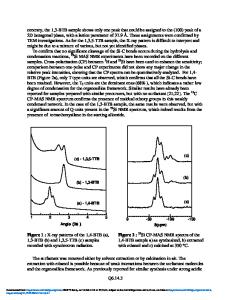Synthesis and characterization of nanometer-sized Ti-based amorphous powders
- PDF / 159,038 Bytes
- 5 Pages / 585 x 783 pts Page_size
- 54 Downloads / 421 Views
B.J. Park and D.H. Kim Department of Metallurgical Engineering, Yonsei University, Seoul 120-749, Korea
W.T. Kim Division of Applied Science, Cheongju University, Cheongju, 360-764, Korea (Received 21 December 2006; accepted 21 March 2007)
We present a simple method for preparing nanometer-sized, Ti-based amorphous powders from the Y28Ti28Al24Co20 and Y36Ti20Al24Co20 two-phase amorphous alloys. The initial microstructure of these rapidly quenched alloys is composed of Ti-based, amorphous, spherical, nanometer-sized particles embedded in a Y-based amorphous matrix, with particle size dependent on the alloy composition. The Ti-based powders were extracted from the two-phase amorphous alloys through selective dissolution of the Y-rich matrix in a 0.1 M HNO3 solution. The powders of size ranging between 20 and 200 nm have smooth and spherical morphology, and exhibit different magnetic behavior than the bulk alloy of identical composition. I. INTRODUCTION
Tailored nanomaterials come in wide-ranging architectures, such as nanofilm, nanotube, and nanoparticle.1 Among these nanomaterials, the synthesis and selfassembly of nanoparticles have been of great interest for innovative research, and applications such as chemical sensing,2 catalysis,3 single electron devices,4 and biomedical applications.5 Several processes enable the production of nanometer-size powders, including chemical vapor deposition, physical vapor deposition, precipitation, reactive sputtering, laser pyrolysis, arc-plasma process, pulse wire explosion, mechanical alloying, grinding, and sol gel.1 While each technique has its own advantages and drawbacks, most of these processes are relatively costly because they usually require sophisticated and expensive equipment, and they must be manipulated by highly qualified technicians. Furthermore, most of these techniques do not allow an easy control of the atomic structure. Among the variety of techniques that can be used to synthesize nanopowders, only a few can produce particles with a metastable structure such as an amorphous phase. The noncrystalline solid structure provides to metallic materials remarkable physical, chemical, and mechanical properties, and several applications have already been proposed for amorphous powders such as catalyst,6 a)
Address all correspondence to this author. e-mail: [email protected] DOI: 10.1557/JMR.2007.0211 1754
J. Mater. Res., Vol. 22, No. 6, Jun 2007
ferrofluids,7 and hydrogen-storage materials.8 Subsequently, as a result of recent progress in the field of metallic glass, resulting in the formation of two-phase metallic glassy alloys,9–11 novel glassy Zr-based microfiber-like structures12 and Ti-based nanoporous glassy material13 were fabricated from the La–Zr–Al–Cu–Ni and Y–Ti–Al–Co two-phase amorphous alloys, respectively. Although a two-phase amorphous glassy structure can be formed in several alloy systems, the existence of the miscibility gap between the Ti–Al–Co and Y–Al–Co phases in a wide range of compositions enables the formation of various types of micros
Data Loading...










